Study of Tribotechnical Properties of Multilayer Nanostructured Coatings and Contact Processes during Milling of Titanium Alloys
Abstract
1. Introduction
2. Theoretical and Experimental Background
- -
- Plastic deformation of a single microuneven (microcutting) as a result of shear by the average diameter of the contact spot;
- -
- The form modification of the surface layer of the wear material as a result of the formation of a wear fragment.
- -
- Reducing the temperature and cutting force.
- -
- Reducing the friction coefficient f (adhesive component) of the frictional contact with the machined material (due to the formation of secondary structures and phases on the working surfaces as products of adaptation (self-organization) of the tribosystem).
- -
- Increasing the hardness ratio of the tool’s contact surfaces and the workpiece (by reducing the dependence of the physical and mechanical properties of the contact surfaces on the temperature in the working zone, considering the phenomena of adaptation (self-organization) during friction) [12,13,23,24,25].
3. Materials and Methods
4. Experimental Results and Discussion
- -
- The nanocomposite coating based on aluminum nitride and titanium nACo3 is a high-tech solid coating applied by physical vacuum deposition and consisting of nanoparticles in a binding amorphous matrix. The uniqueness of the coating lies in the successful combination of physically mutually exclusive parameters: while increasing the hardness, its elasticity increases at the same time;
- -
- The nanocomposite coating based on chrome and aluminum carbonitrides nACRo has very high hardness at elevated cutting temperatures;
- -
- Titanium diboride TiB2 nanocomposite coating is a synthetic, particularly hard, heat-resistant, refractory, and wear-resistant material. These coatings are advantageous due to their high hardness and resilience as well as good abrasion resistance.
- -
- Diamond-like coating (DLC) is a diamond-like carbon material with a tough and friction-reducing coating on top of other conventional wear-resistant coatings in most cases.
- -
- Milling of titanium alloy Ti64 was ensured when using wear-resistant coatings: improvement by 2.4 times with “nACRo+TiB2” coating, by 2.2 times with “nACo3+TiB2”, and by 2 times with “nACRo” coating compared to milling without coating;
- -
- Milling of titanium alloy Ti811 was provided with wear-resistant coating: improvement by 4 times with “nACRo” coating and improvement by 2 times with “nACRo+TiB2” coating in comparison with milling without coating.
- -
- Milling of titanium alloy Ti64 was provided when using wear-resistant coatings: improvement by 18% with “nACRo + TiB2” coating and by 17% with “nACRo + TiB2 + epilama” coating in comparison with “nACo3” coating;
- -
- Milling of titanium alloy Ti811 was ensured when using wear-resistant coatings: improvement by 1.8 times with “nACRo” coating and by 1.5 times with “nACo3 + TiB2 + epilama” coating in comparison with “nACo3” coating.
- -
- For milling of Ti64 titanium alloy, an increase in TiB2 coating time of more than 30 min does not contribute to the increase in wear resistance of the milling cutter.
- -
- The lowest cutting temperature value is provided when using “nACRo + TiB2” coating when milling Ti64 and Ti811 titanium alloys, and they are lower by 9% and 12%, respectively, relative to uncoated machining;
- -
- Milling of Ti64 titanium alloy is less heat-intensive compared to Ti811.
- -
- The lowest value of cutting force is provided when using “nACRo3 + TiB2” coating for both titanium alloy Ti64 and alloy Ti811 with 1.5–2 times less force in comparison with milling without coating;
- -
- Milling of titanium alloy Ti64 has less force loading in comparison with Ti811 by 1.5–2 times.
- -
- The most effective coatings in terms of contact processes on a single contact spot and adhesion coefficient are the coatings applied on “Platit π411”: nACo3, nACRo, and nACRo + TiB2;
- -
- The lowest coefficient of adhesion interaction between the tool material and the machined material in the whole investigated temperature range is provided by coating nACRo + TiB2 on titanium alloys Ti64 and Ti811, which confirms the best coating adhesion with the substrate and allows using them for high-speed milling.
5. Conclusions
- The thermodynamic model of cutting tool wear is proposed, allowing us to determine ways to reduce the intensity of cutting tool wear and the dissipative function of the tool material shape change during tool wear, and the conditions for improving the wear resistance of the cutting tool using the phenomenon of adaptation (self-organization) under friction are formulated.
- Experimental studies on the wear resistance of cutting tools with different coatings have shown that, during milling of titanium alloys, a significant increase in wear resistance is provided when using innovative multilayer nanostructured coatings, with an improvement on average of 1.5–2 times.
- 3.
- Important in the analysis are the results of metallurgical research, as the obtained data allow one to assert that, in contact processes, there is a phenomenon of adaptation (self-organization) of friction surfaces at cutting by a tool with wear-resistant coatings, promoting the formation of films of various compounds with shielding, protective, and lubricating properties, in particular Al2O3, TiO2, etc. These films have an amorphous-like structure with high plasticity and improved lubricity. This is confirmed by spectroscopic studies and above all by the low-intensity peaks found at long atomic distances on Fourier transforms.
Author Contributions
Funding
Institutional Review Board Statement
Informed Consent Statement
Data Availability Statement
Conflicts of Interest
References
- Vereshchaka, A.S.; Kushner, V.S. Cutting Materials; Higher School: Moscow, Russia, 2009; 336p. [Google Scholar]
- Kabaldin, Y.G.; Semibratova, M.V.; Kirichenko, V.V. Self-organization in friction processes during cutting. In Proceedings of the Tomsk Polytechnic University Proceedings of TPU, Tomsk, Russia, 25–26 April 2002; Volume 305, pp. 95–100. [Google Scholar]
- Makarov, A.D. Optimization of Cutting Processes; Mechanical Engineering: Moscow, Russia, 1976; 150p. [Google Scholar]
- Loladze, T.N. Durability and Wear Resistance of Cutting Tools; Mechanical Engineering: Moscow, Russia, 1982; 320p. [Google Scholar]
- Matalin, A.A. Engineering Technology: University Textbook; Mechanical Engineering: Moscow, Russia, 1985; 512p. [Google Scholar]
- Zoritkuev, V.C. Identification and Automatic Control of Technological Processes in Machine-Tool Systems: A Training Manual; USATU: Ufa, Russia, 1993; 118p. [Google Scholar]
- Andrievsky, R.A.; Ragulia, A.V. Nanostructured Materials; Academia Publishing Center: Moscow, Russia, 2005; 192p. [Google Scholar]
- Gusev, A.I.; Rempel, A.A. Nanocrystalline Materials; Fizmatlit: Moscow, Russia, 2004; 327p. [Google Scholar]
- Panov, D.O.; Simonov, Y.N.; Leont’ev, P.A.; Smirnov, A.I.; Zayats, L.T. A study of phase and structural transformations of hardened low-carbon steel under conditionsof multiple intense heat effect. Met. Sci. Heat Treat. 2013, 54, 582–586. [Google Scholar] [CrossRef]
- Beresnev, V.M.; Pogrebniak, A.D.; Azarenkov, N.A.; Farenik, V.I.; Kirik, G.V. Nanocrystalline and nanocomposite coatings, structure, properties. FIP 2007, 5, 4–27. [Google Scholar]
- Levashov, E.A.; Shtanskii, D.V. Multifunctional nanostructured films. Uspekhi Chem. 2007, 76, 501–509. [Google Scholar] [CrossRef]
- Shuster, L.S. Adhesion Interaction of Solid Metal Bodies; Publishing House GILEM: Ufa, Russia, 1999; 199p, Available online: http://www.prometeus.nsc.ru/exhibit/28-11-00/index2.ssi (accessed on 27 December 2022).
- Tabakov, V.P.; Smirnov, M.Y.; Tsirkin, A.V. Serviceability of End Mills with Multilayer Wear-Resistant Coatings; Ulyanovsk State Technical University: Ulyanovsk, Russia, 2005; 151p. [Google Scholar]
- Cantero, J.L.; Diaz-Alvarez, J.; Migueles, M.J.; Marin, N.K. Analysis of tool wear patterns in Inconel 718 turning. Wear 2013, 297, 885–894. [Google Scholar] [CrossRef]
- Migranov, M.S. Enhancement of Tool Wear Resistance Based on the Prediction of Processes of Adaptation of Friction Surfaces When Cutting Metal. Ufimsky iz-"Gilem". Ph.D. Thesis, 2011; p. 229. Available online: https://www.dissercat.com/content/povyshenie-iznosostoikosti-instrumentov-na-osnove-prognozirovaniya-protsessov-adaptatsii-pov (accessed on 27 December 2022).
- Vereshchaka, A.; Aleksandrov, I.; Muranov, A.; Mikhailov, M.; Tatarkanov, A.; Milovich, F.; Andreev, N.; Migranov, M. Study of tribological and performance properties of (mex, moy, al1-(x+y))n (me -ti, zr or cr) coatings. Tribol. Int. 2022, 165, 107305. [Google Scholar] [CrossRef]
- Fox-Rabinovich, G.S.; Weatherly, G.C.; Dodonov, A.I.; Kovalev, A.I.; Shuster, L.S.; Veldhuis, S.C.; Dosbaeva, G.K.; Wainstein, D.L.; Migranov, M.S. Nanocrystalline filtered arc TiAlN PVD coatings for high-speed machining. Surf. Coat. Technol. 2004, 177, 800–811. [Google Scholar] [CrossRef]
- Fox-Rabinovich, G.S.; Kovalev, A.I.; Shuster, L.S.; Bokiy, Y.F.; Dosbaeva, G.K.; Vainshtein, D.L.; Mishina, V.P. Characteristics of VSS alloying—Based on deformed composite powder materials taking into account the self-organization of the tool during cutting. Wear 2006, 1997, 214. [Google Scholar] [CrossRef]
- Prengel, H.G.; Jindal, P.C.; Wendt, K.H.; Santhanam, A.T.; Hegde, P.L.; Penich, R.M. A new class of high-performance PVD coatings for carbide cutting tools. Surf. Coat. Technol. 2001, 139, 25–34. [Google Scholar] [CrossRef]
- Haubner, R.; Lessiak, M.; Pitonak, R.; Köpf, A.; Weissenbacher, R. Evolution of traditional hard coatings for use on cutting tools. Int. J. Refract. Met. Hard. Mater. 2017, 62, 210–218. [Google Scholar] [CrossRef]
- Zhao, D.X.; Bui, C.T.; Zeng, X.T. Abrasion wear resistance of Ti1—XAlXN hard coatings deposited by vacuum arc system with side rotating cathodes. Surf. Coat. Technol. 2008, 203, 680–684. [Google Scholar] [CrossRef]
- LaGrange, D.D.; LaGrange, T.; Santana, A.; Jähnig., R. Macroparticle formation during cathodic-arc deposition of nitride coatings from alloy cathodes TiNb. J. Vac. Sci. Technol. A Vac. Surf. Film. 2017, 35, 021309. [Google Scholar] [CrossRef]
- Alami, J.; Eklund, P.; Emmerlich, J.; Wilhelmsson, O.; Jansson, U. Powerful pulsed magnetron sputtering of Ti-Si-C thin films from a composite Ti3 SiC2 target. Thin Solid Film. 2006, 515, 1731–1736. [Google Scholar] [CrossRef]
- Zhou, H.; Zheng, J.; Gui, B.; Geng, D.; Wang, Q. AlTiCrN deposited by HIPIMS/DC hybrid magnetron sputtering. Vacuum 2017, 136, 129–136. [Google Scholar] [CrossRef]
- Shuster, L.S. Adhesive Interaction of Solid Metal Bodies; Gilem Publishing House: Ufa, Russia, 1999; 198p, Available online: https://search.rsl.ru/ru/record/01000652403 (accessed on 27 December 2022).
- Shuster, L.S.; Migranov, M.S. Device for the Study of Adhesive Interaction. Useful Model Patent No. 34249, 24 June 2003. [Google Scholar]
- Haršáni, M.; Ghafoor, N.; Calamba, K.; Zacková, P.; Sahul, M.; Vopát, T.; Satrapinskyy, L.; Čaplovičová, M.; Čaplovič, Ľ. Adhesion-strain relationships and mechanical properties of nc-AlCrN/a-SiNXhard coatings deposited at different displacement stresses. Thin Solid Film. 2018, 650, 11–19. [Google Scholar] [CrossRef]
- Migranov, M.S. Study of wear of tool materials and coatings from the position of thermodynamics and self-organization. Izvestiya vysshee uchebnykh obucheniya Proceedings of higher educational institutions. Mech. Eng. 2006, 11, 65–70. [Google Scholar]
- Migranov, M.S.; Mukhamadeev, V.R.; Migranov, A.M.; Mukhamadeev, I.R.; Khazgalieva, A.A. Structure and phase changes in nanostructured combined coatings in the collection. IOP Conf. Ser. Mater. Sci. Eng. 2018, 447, 012082. [Google Scholar] [CrossRef]
- Migranov, M.S.; Shuster, L.S. Wear resistance of cutting tools with multilayer coatings. Frict. Wear 2005, 26, 304–307. [Google Scholar]
- Cselle, T.; Coddet, O.; Galamand, C.; Holubar, P.; Jilek, M.; Jilek, J.; Luemkemann, A.; Morstein, M. TripleCoatings3®-New Generation of PVD-Coatings for Cutting Tools. J. Mach. Manuf. 2009, 49, 19–25. [Google Scholar]
- Veprek, S.; Jilek, M. Superhard and functional nanocomposites formed by self-organization versus hardening of coatings by energy ion bombardment during their deposition. Rev. Adv. Mater. Sci. 2003, 5, 6–16. [Google Scholar]
- Sobol, O.V.; Andreev, A.A.; Grigoriev, S.N.; Volosova, M.A.; Gorban, V.F. Vacuum arc multi-layer nanostructured TiN/Ti coatings: Structure, stress state, properties. Met. Sci. Heat Treat. 2012, 54, 28–33. [Google Scholar] [CrossRef]
- Grigoryev, S.N.; Vereshchaka, A.A.; Fedorov, S.V.; Sitnikov, N.N.; Batako, A.D. Comparative analysis of cutting properties and wear character of carbide cutting tools with multilayer nanostructure and gradient coatings obtained using different spraying methods. Int. J. Adv. Manuf. Technol. 2017, 90, 3421–3435. [Google Scholar] [CrossRef]
- Vereschaka, A.; Tabakov, V.; Grigoriev, S.; Sitnikov, N.; Milovich, F.; Andreev, N.; Bublikov, J. Investigation of wear mechanisms of a cutting tool surface with multilayer composite nanostructured Cr-CrN-(Ti,Cr,Al,Si)N coating during high-speed steel turning. Wear 2019, 438–439, 203069. [Google Scholar] [CrossRef]
- Vereshchaka, A.; Tabakov, V.; Grigoryev, S.; Sitnikov, N.; Milovich, F.; Andreev, N.; Sotova, K.; Kutina, N. Study of the in-fluence of nanolayer thickness in Ti-TiN-(Ti,Cr,Al)N coating wear layers on cutting failure and wear of carbide cutting tools. Surf. Coat. Technol. 2020, 385, 125402. [Google Scholar] [CrossRef]
- Grigoriev, S.N.; Volosova, M.A.; Vereschaka, A.A.; Sitnikov, N.N.; Milovich, F.; Bublikov, J.I.; Fyodorov, S.V.; Seleznev, A.E. Properties of composite coatings (Cr,Al,Si)N-(DLC-Si) deposited on a cutting ceramic substrate. Ceram. Int. 2020, 46, 18241–18255. [Google Scholar] [CrossRef]
- Grigoryev, S.N.; Vereshchaka, A.A.; Milovich, F.; Bublikov, Y. Investigation of multicomponent nanolayer coatings based on Cr, Mo, Zr, Nb and Al nitrides. Surf. Coat. Technol. 2020, 401, 126258. [Google Scholar] [CrossRef]
- Grigoryev, S.N.; Vereshchaka, A.A.; Milovich, F.; Sitnikov, N.; Ohanyan, G.V. Study of tribological properties of Ti-TiN-(Ti,Al,Nb,Zr)N composite coating and its effectiveness in increasing the wear resistance of metal cutting tools. Tribol. Int. 2021, 164, 107236. [Google Scholar] [CrossRef]
- Migranov, M.; Migranova, R. Tool coatings with the effect of adaptation to cutting conditions. Key Eng. Mater. 2012, 496, 75–79. [Google Scholar] [CrossRef]
- Grigoriev, S.; Vereschaka, A.; Zelenkov, V.; Sitnikov, N.; Bublikov, J.; Milovich, F.; Andreev, N.; Mustafaev, E. Specific features of the structure and properties of arc-PVD coatings depending on the spatial arrangement of the sample in the chamber. Vacuum 2022, 200, 111047. [Google Scholar] [CrossRef]
- Grigoriev, S.; Vereschaka, A.; Zelenkov, V.; Sitnikov, N.; Bublikov, J.; Milovich, F.; Andreev, N.; Sotova, C. Investigation of the influence of the features of the deposition process on the structural features of microparticles in PVD coatings. Vacuum 2022, 202, 111144. [Google Scholar] [CrossRef]
- Fox-Rabinovich, G.S.; Yamamoto, K.; Veldhuis, S.K.; Kovalev, A.I.; Dosbaeva, G.K. Tribological adaptability of TiAlCrN PVD coatings under high-performance dry processing. Surf. Coating. Technol. 2005, 200, 1804–1813. [Google Scholar] [CrossRef]
- Vereshchaka, A.; Grigoriev, S.; Milovich, F.; Sitnikov, N.; Migranov, M.; Andreev, N.; Bublikov, Y.; Sotova, K. Study of tribological and functional properties of Cr, Mo-(Cr,Mo)N-(Cr,Mo,Al)N multilayer composite coating. Tribol. Int. 2021, 155, 106804. [Google Scholar] [CrossRef]
- Yamamoto, K.; Kujime, S.; Takahara, K. Structural and mechanical properties of Si (Ti, Cr, Al)N inclusion coatings deposited by arc ion plating. Surf. Coating. Technol. 2005, 200, 1383–1390. [Google Scholar] [CrossRef]
- Zhang, J.; Lv, H.; Cui, G.; Jing, Z.; Wang, C. Effect of displacement stress on microstructure and mechanical properties of (Ti;Al,Cr)N solid films with Ngrandent distribution. Thin Solid Films 2011, 519, 4818–4823. [Google Scholar] [CrossRef]
- Forsén, R.; Johansson, M.P.; Odén, M.; Ghafoor, N. Effect of Ti doping of AlCrN coatings on thermal stability and oxidation resistance. Thin Solid Films 2013, 534, 394–402. [Google Scholar] [CrossRef]
- Grigoryev, S.N.; Abadias, G.; Saladukhin, I.A.; Uglov, V.V.; Zlotski, S.V.; Eyidi, D. Thermal stability and oxidation behavior of quaternary TiZrAlN magnetron sputtered thin films: Influence of the pristine microstructure. Surf. Coat. Technol. 2013, 237, 187–195. [Google Scholar]
- Nguyen, T.D.; Kim, Y.J.; Han, J.G.; Lee, D.B. Oxidation of TiZrAlN nanocomposite thin films in air at temperatures between 500 and 700 °C. Thin Solid Films 2009, 517, 5216–5218. [Google Scholar] [CrossRef]
- Sergeyevnin, V.S.; Blinkov, I.V.; Volkhonskii, A.O.; Belov, D.S.; Kuznetsov, D.V.; Gorshenkov, M.V.; Skryleva, E.A. Wear-resistant adaptive nanomultilayer Ti-Al-Mo-N coatings. Appl. Surf. Sci. 2016, 388, 13–23. [Google Scholar] [CrossRef]
- Bobzin, K.; Brogelmann, T.; Kalscheuer, K.; Stah, L.K.; Lochner, T.; Yilmaz, M. Effect of (Cr,Al)N and (Cr,Al,Mo)N coatings on friction under minimum lubrication. Surf. Coating. Technol. 2020, 402, 126154. [Google Scholar] [CrossRef]
- Ju, H.; Yu, D.; Xu, J.; Yu, L.; Bin, Z.; Geng, Y.; Huang, T.; Shao, L.; Ren, L.; Du, C.; et al. Crystal structure and tribological properties of ZrAlMoN composite films deposited by magnetron sputtering. Mater. Chem. Phys. 2019, 230, 347–354. [Google Scholar] [CrossRef]
- Ilo, S.; Tomala, A.; Badish, E. Oxidative wear kinetics in sliding contact of unlubricated steel. Tribol. Int. 2011, 44, 1208–1215. [Google Scholar] [CrossRef]
- Chen, Z.; Lou, M.; Geng, D.; Xu, Y.X.; Wang, Q.; Zheng, J.; Zhu, R.; Chen, Y.; Kim, K.H. Effect of the modulation geometry on mechanical and tribological properties of TiSiN/TiAlN nano-multilayer coatings. Surf. Coating. Technol. 2021, 423, 127586. [Google Scholar] [CrossRef]
- Povstugar, I.; Choi, P.-P.; Tytko, D.; Ahn, J.-P.; Raabe, D. Interface-directed spinodal decomposition in TiAlN/CrN multilayer hard coatings studied by atom probe tomography. Acta Mater. 2013, 61, 7534–7542. [Google Scholar] [CrossRef]
- Han, J.; Cao, K.; Xiao, L.; Tan, X.; Li, T.; Xu, L.; Tang, Z.; Liao, G.; Shi, T. In situ measurement of cutting-edge temperature during turning using near infrared fiber optic two-color pyrometer. Meas. J. Int. Confed. Meas-Urem. 2020, 156, 107595. [Google Scholar]
- Baltatu, M.S.; Vizureanu, P.; Sandu, A.V.; Munteanu, C.; Istrate, B. Microstructural Analysis and Tribological Behavior of Ti-Based Alloys with a Ceramic Layer Using the Thermal Spray Method. Coatings 2020, 10, 1216. [Google Scholar] [CrossRef]
- Baltatu, M.S.; Sandu, A.V.; Nabialek, M.; Vizureanu, P.; Ciobanu, G. Biomimetic Deposition of Hydroxyapatite Layer on Titanium Alloys. Micromachines 2021, 12, 1447. [Google Scholar] [CrossRef] [PubMed]
- Baltatu, I.; Sandu, A.V.; Vlad, M.D.; Spataru, M.C.; Vizureanu, P.; Baltatu, M.S. Mechanical Characterization and In Vitro Assay of Biocompatible Titanium Alloys. Micromachines 2022, 13, 430. [Google Scholar] [CrossRef]
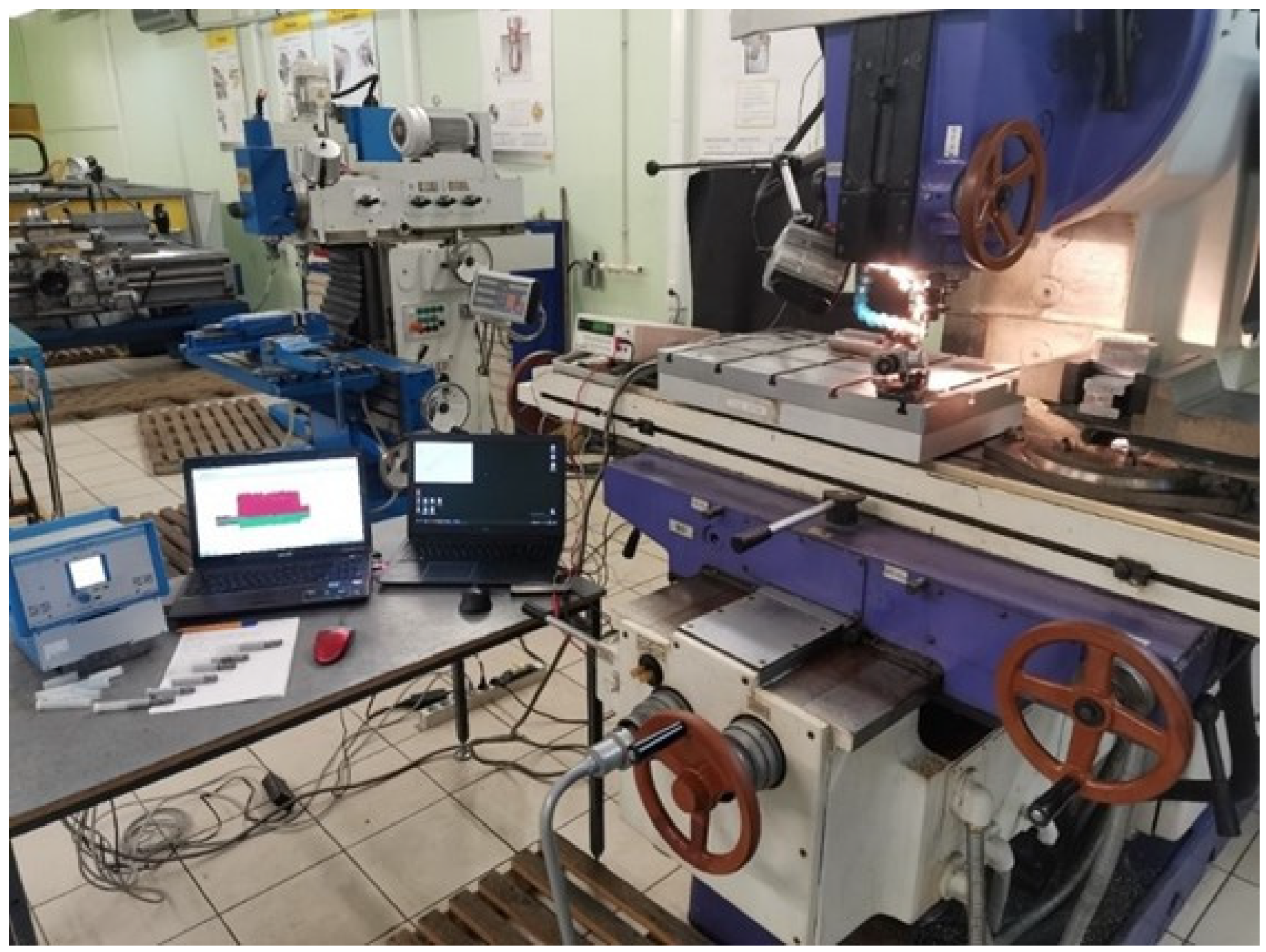
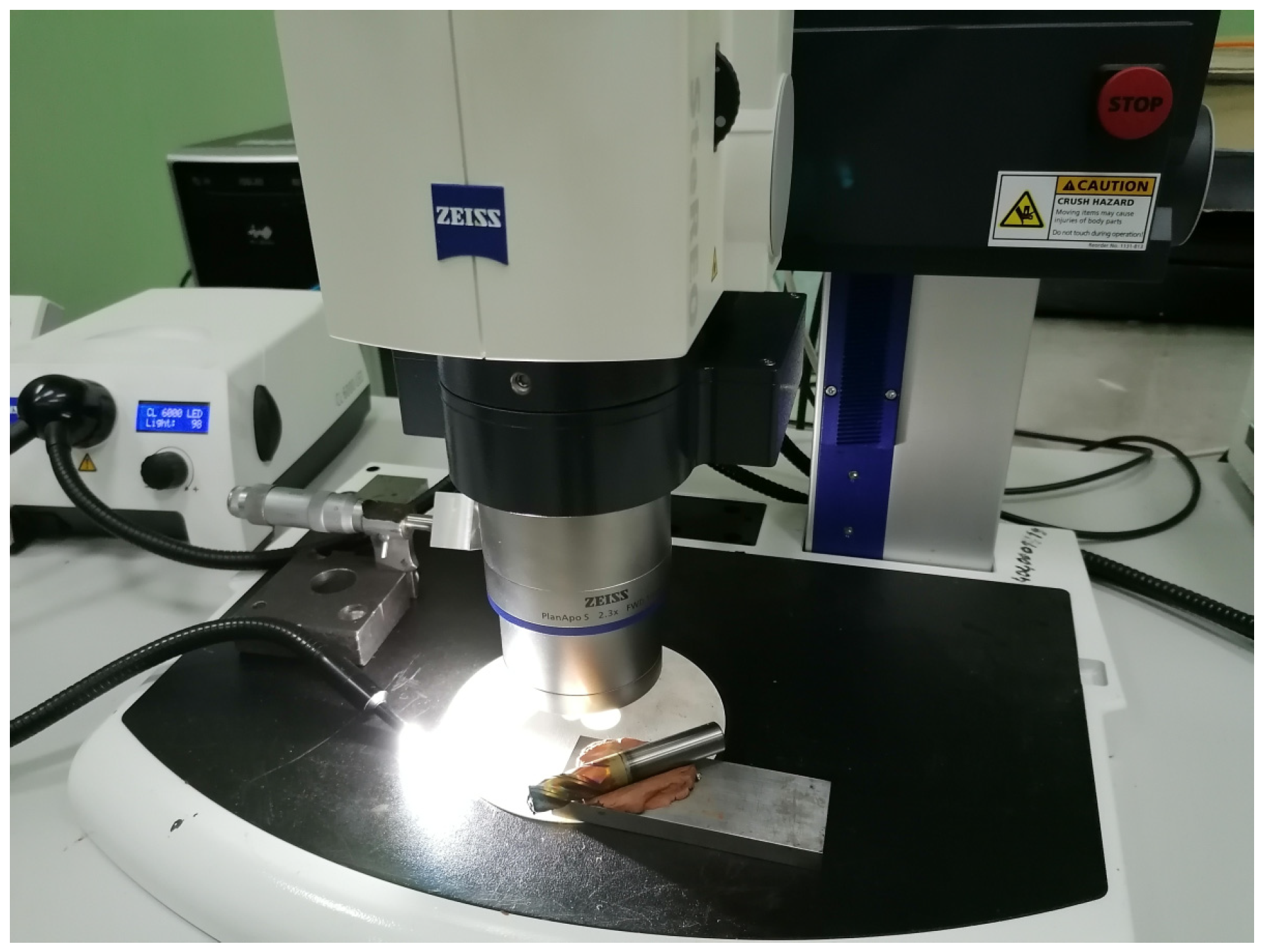
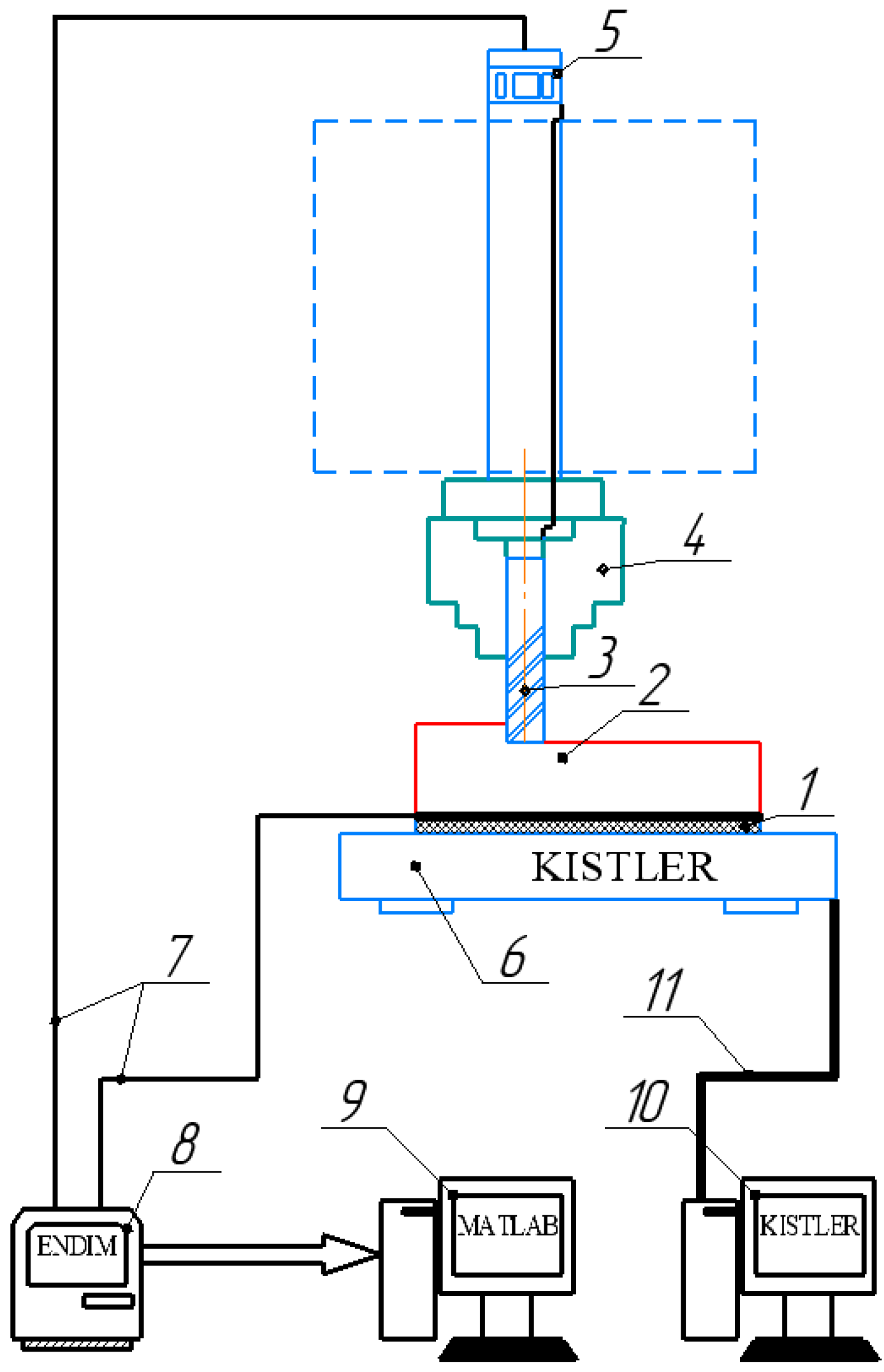


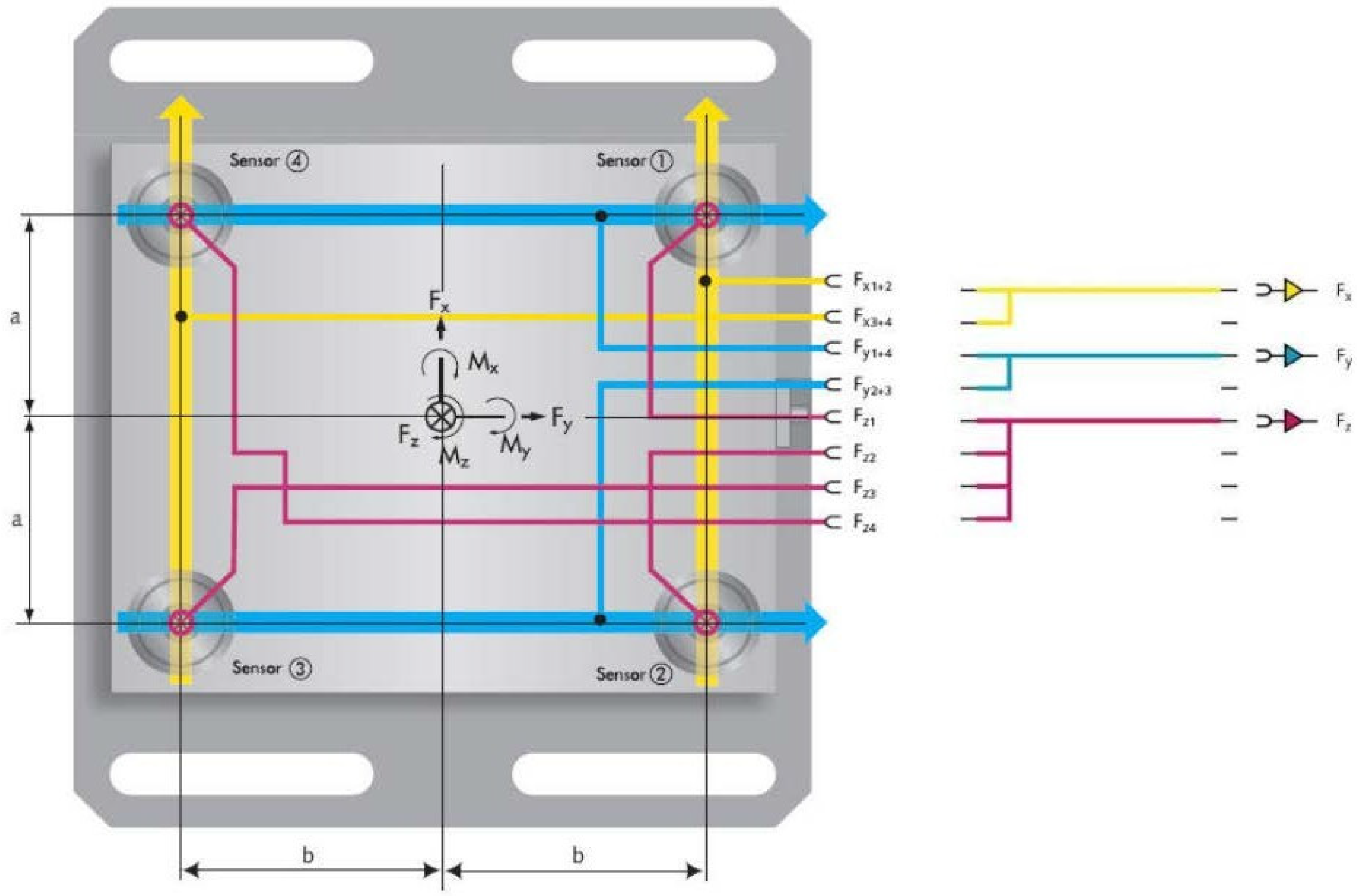


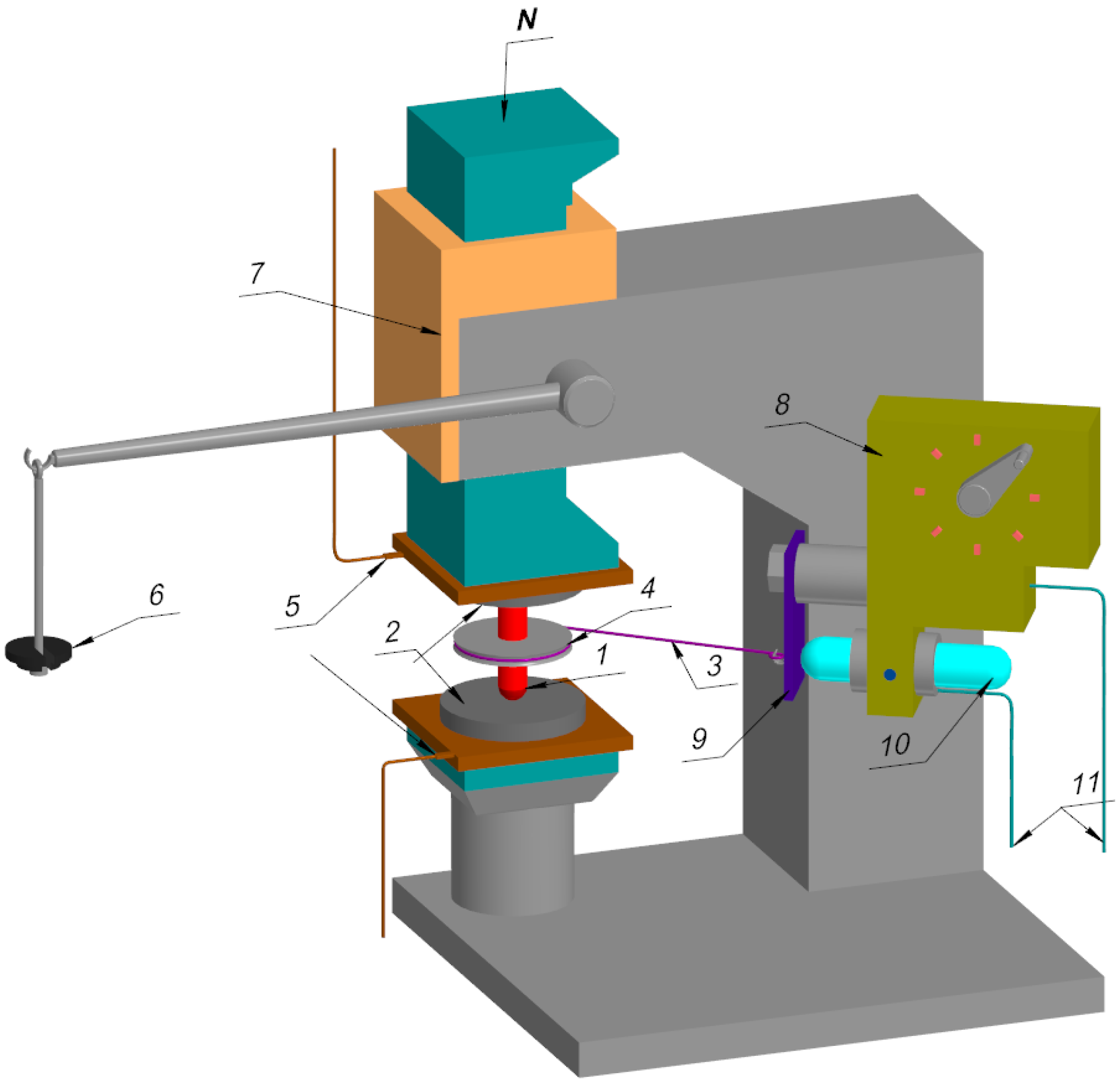

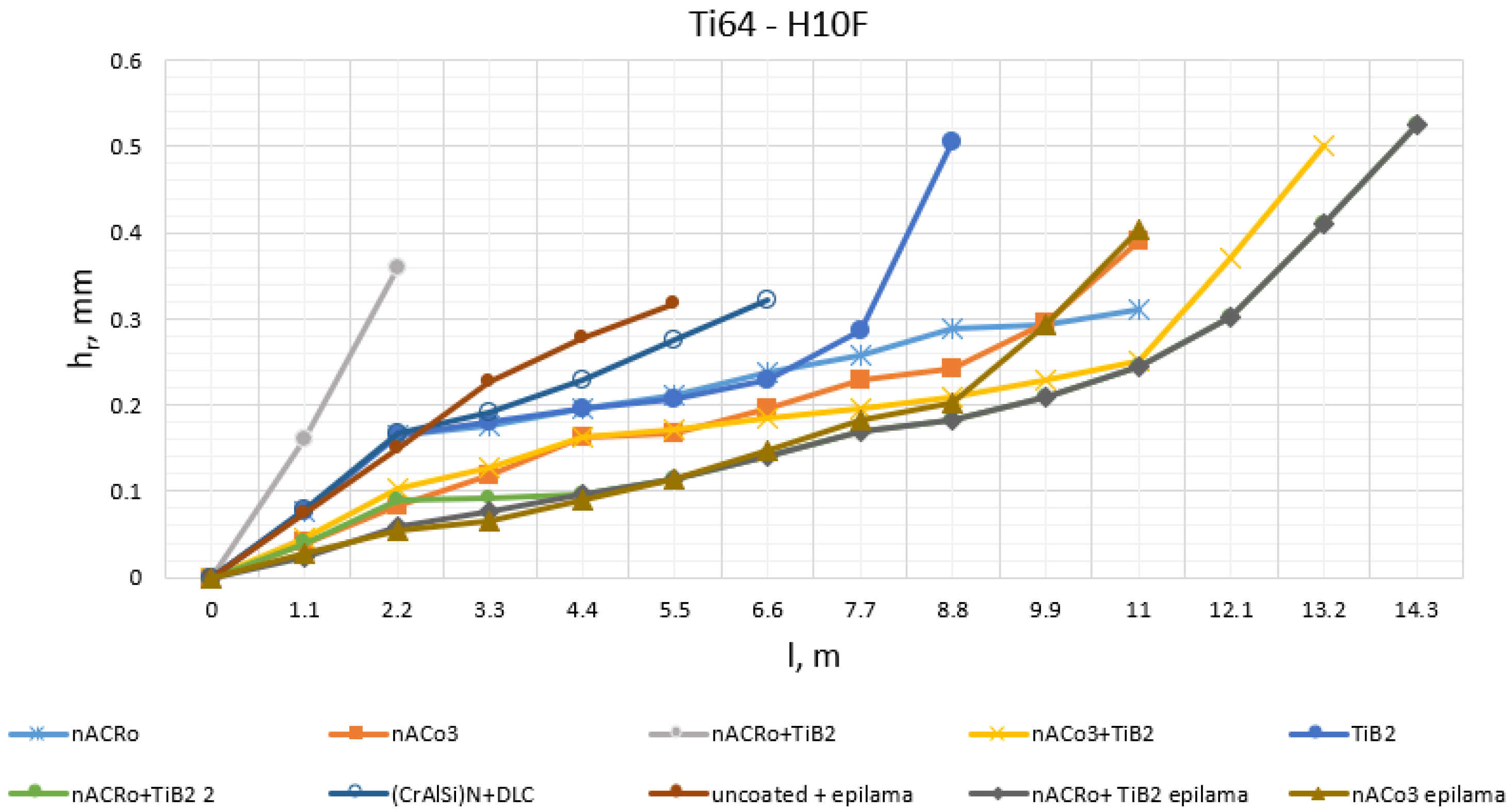
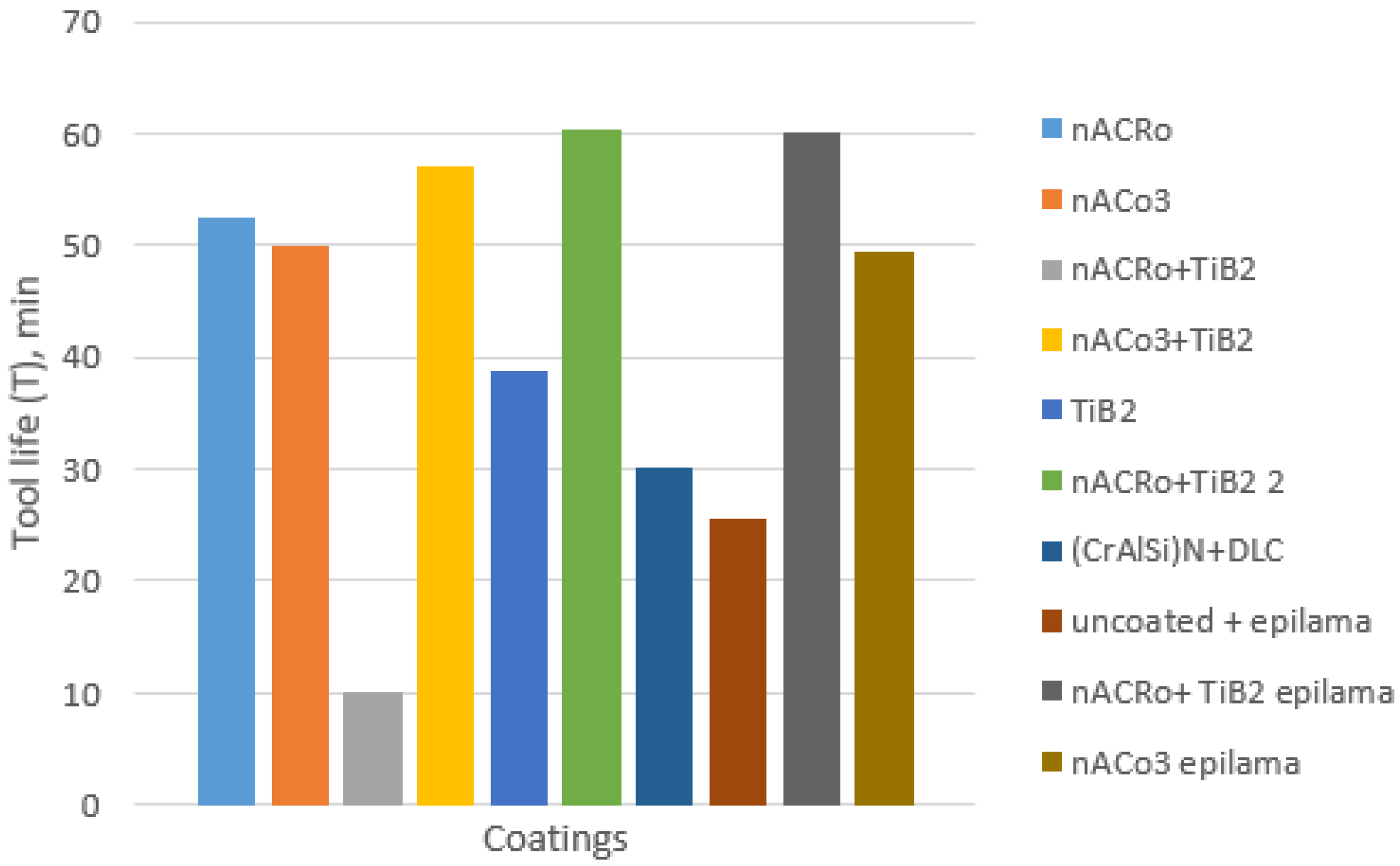

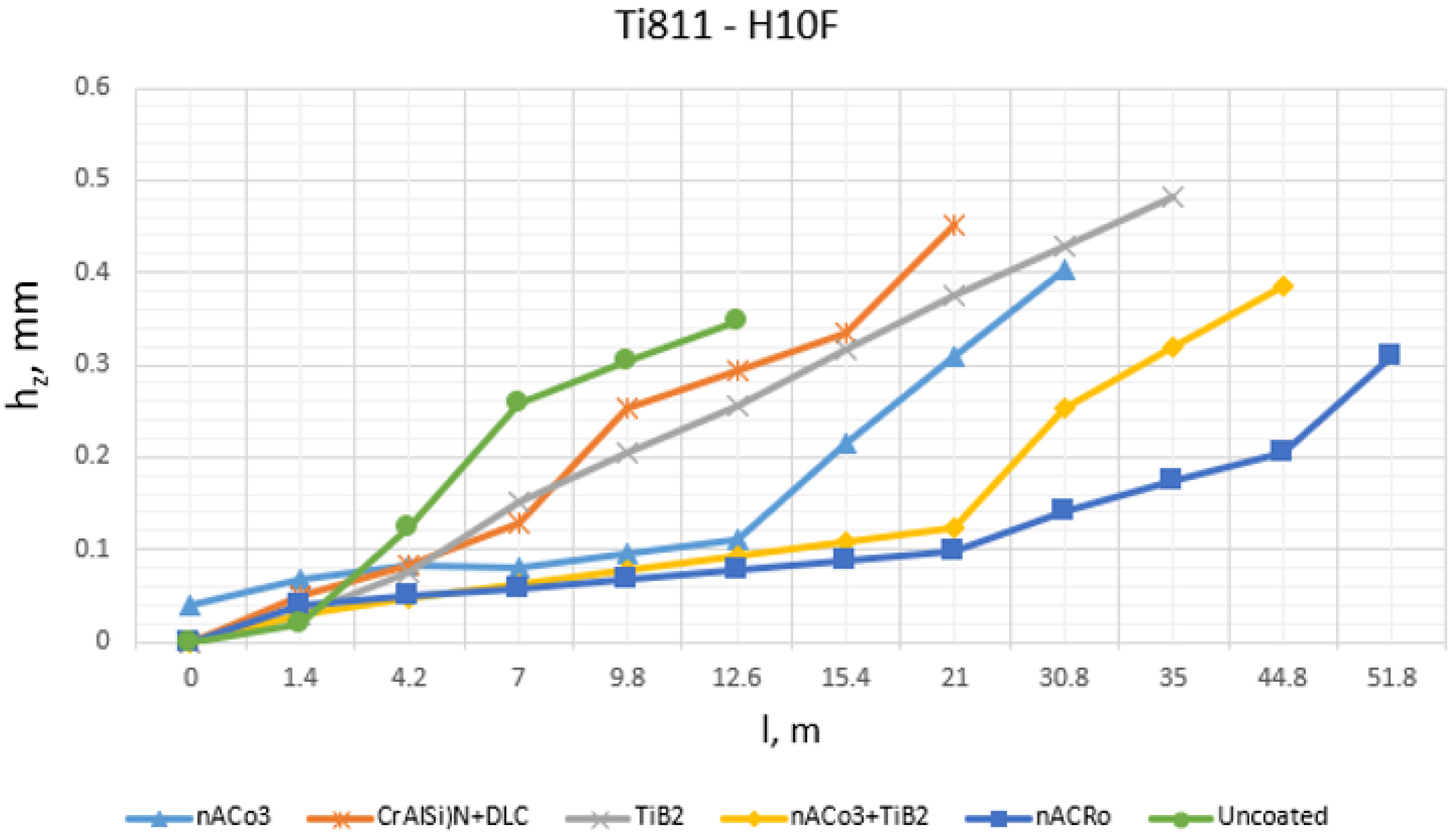
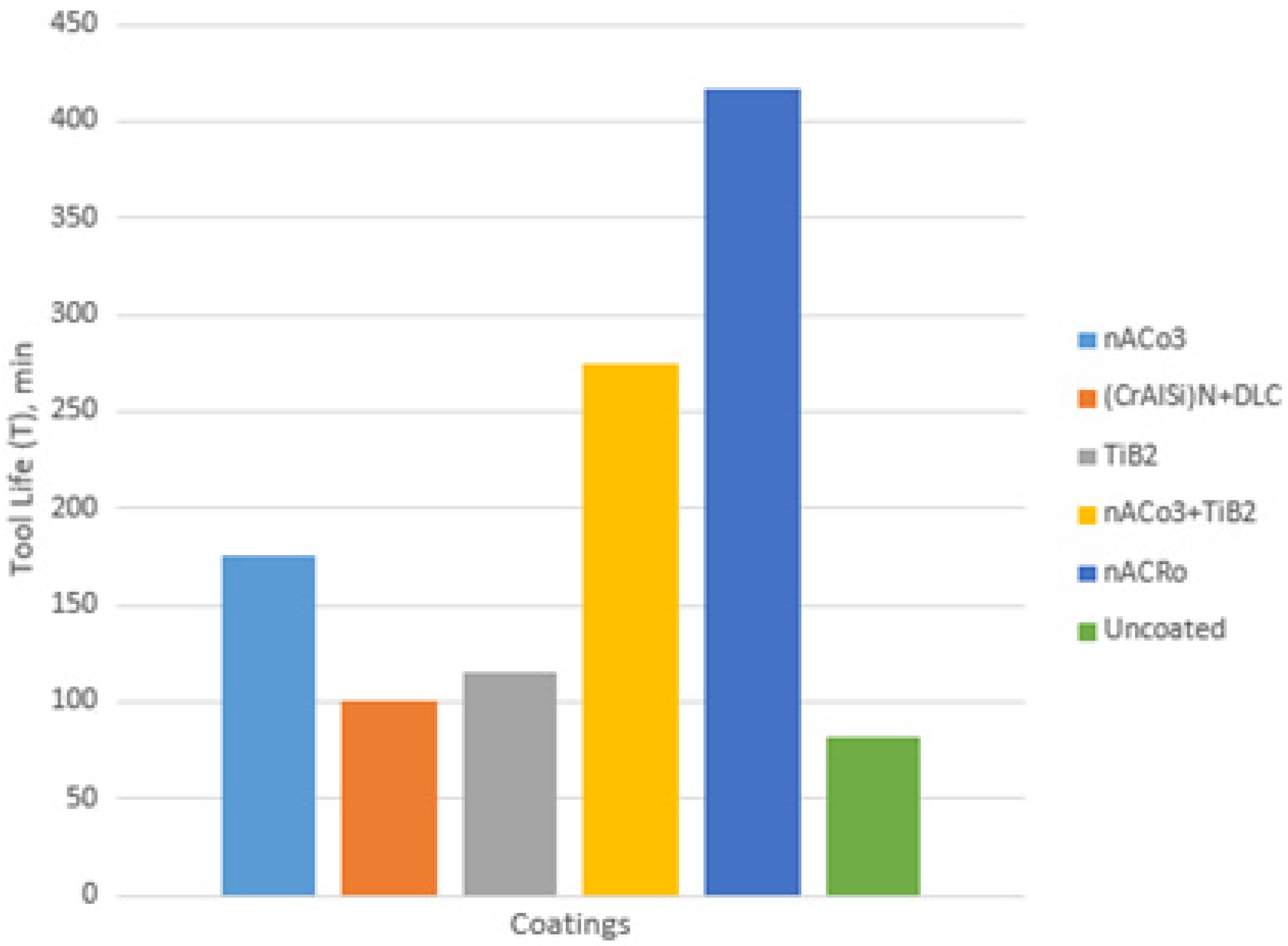
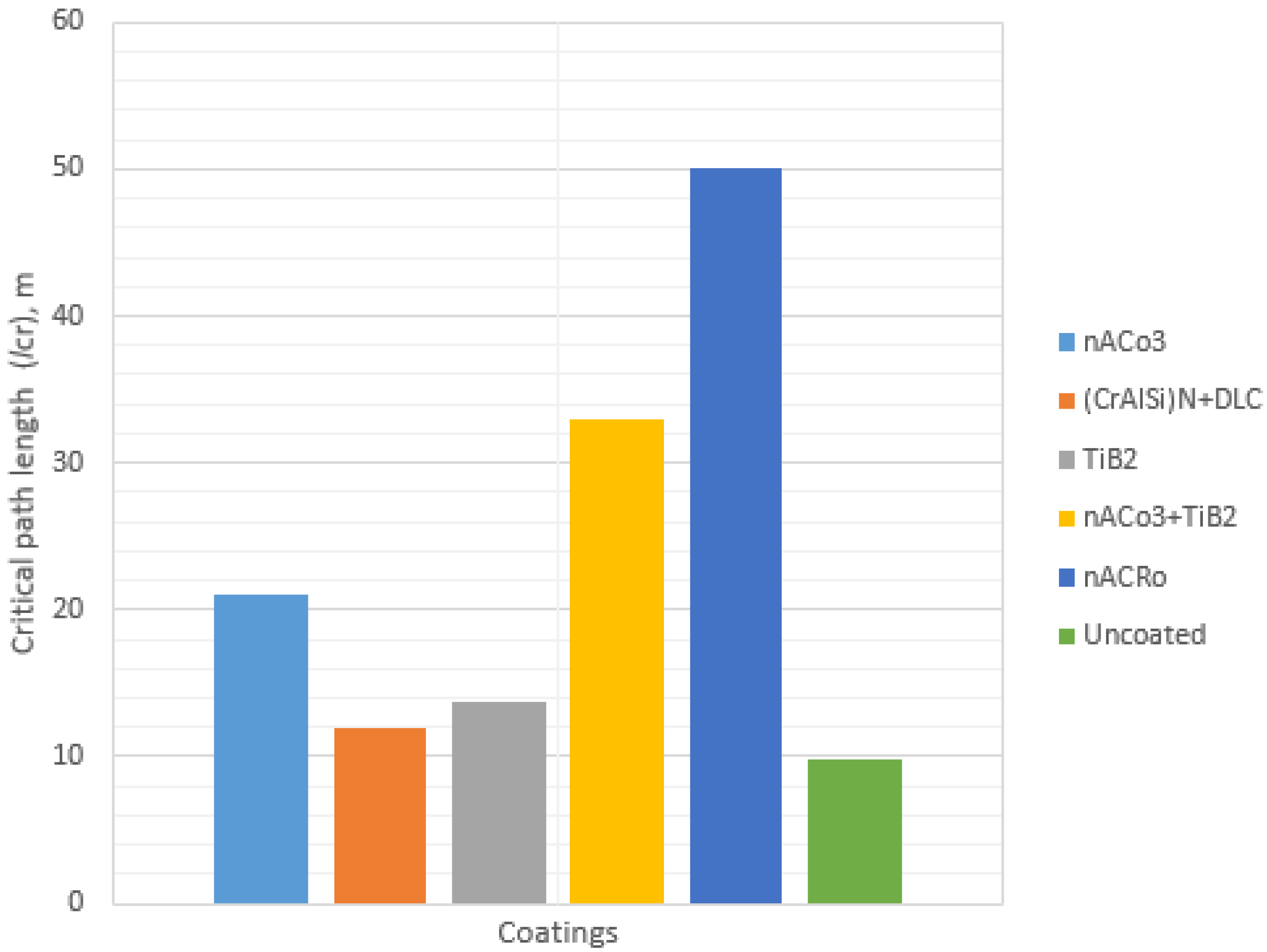

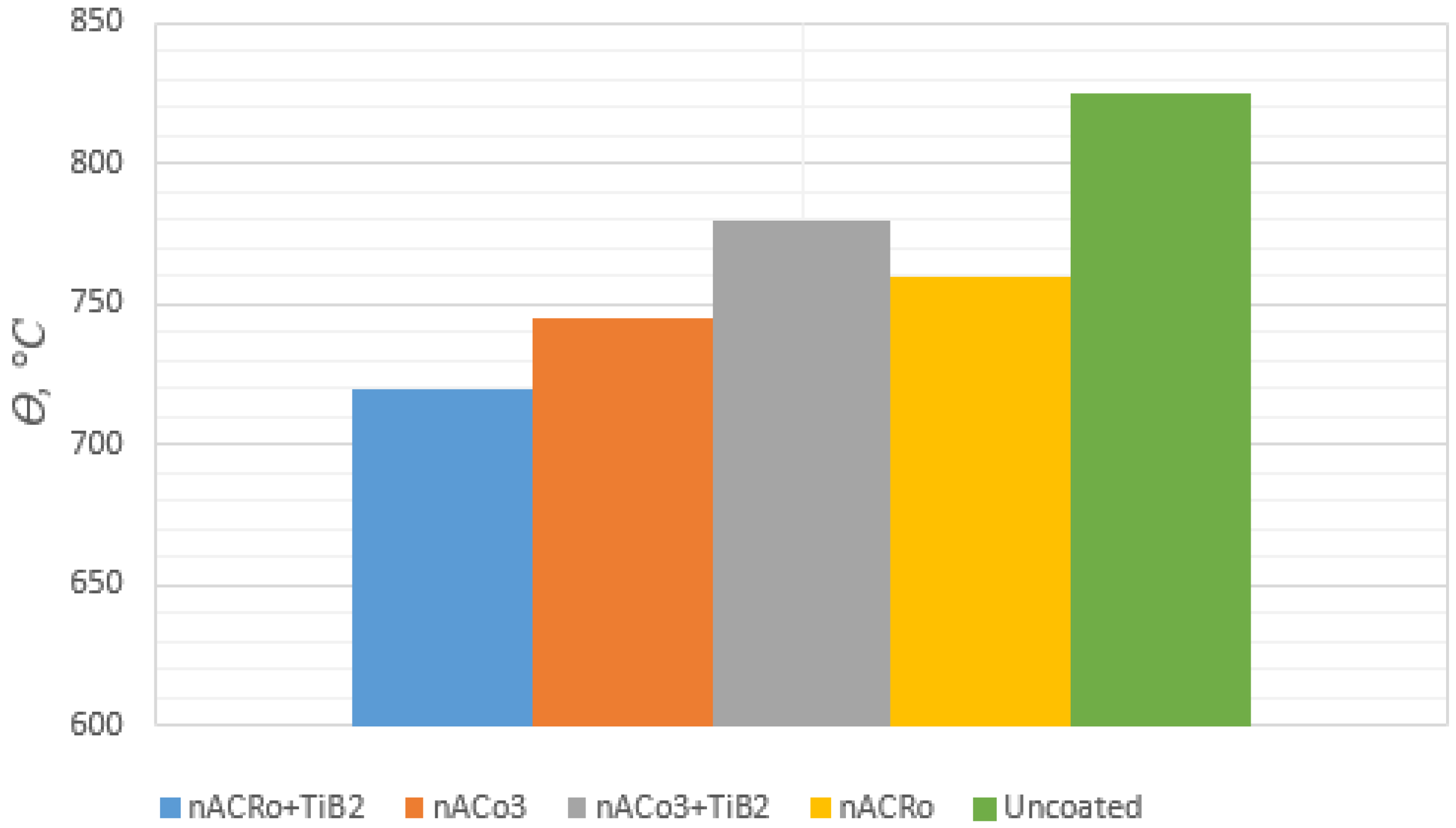


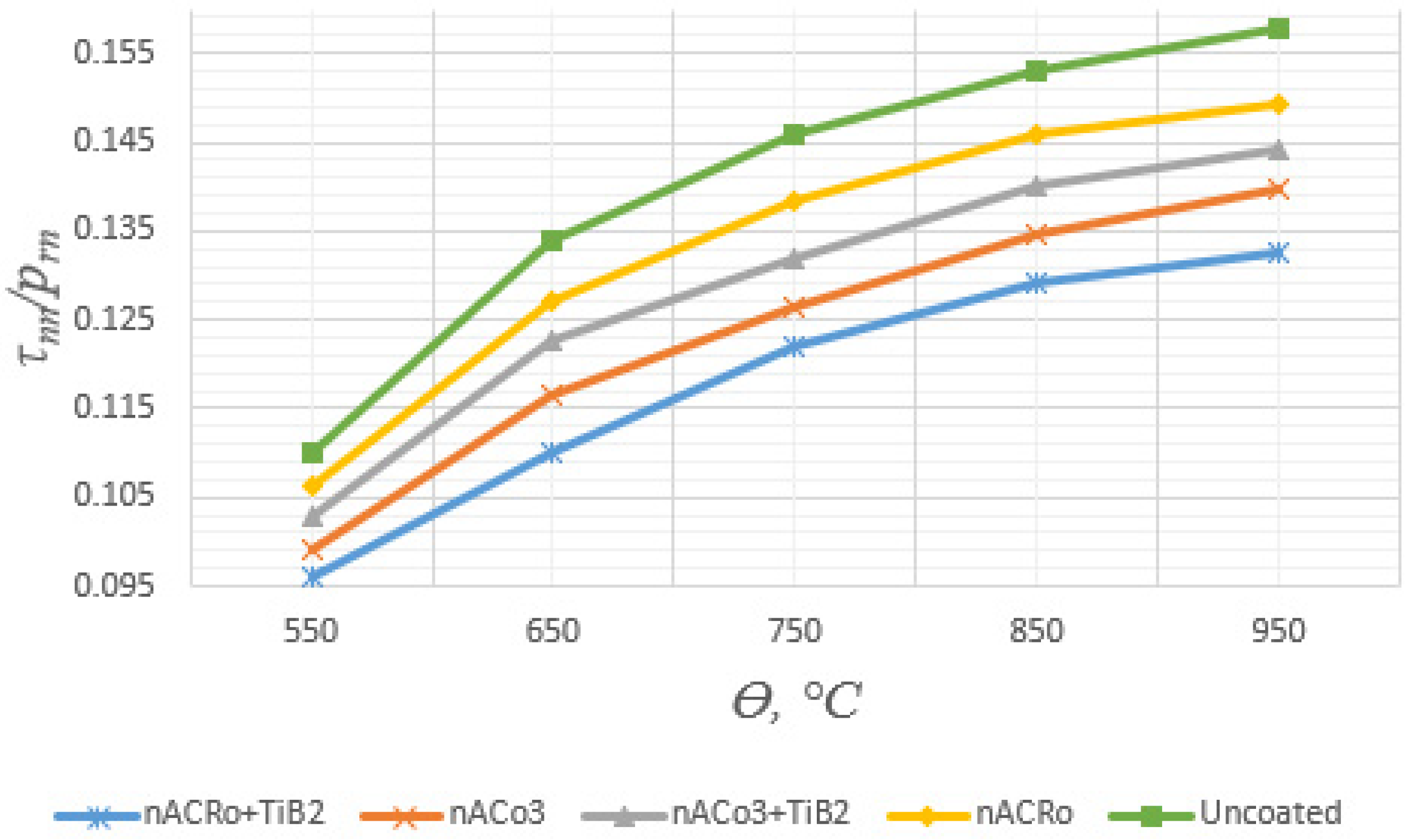
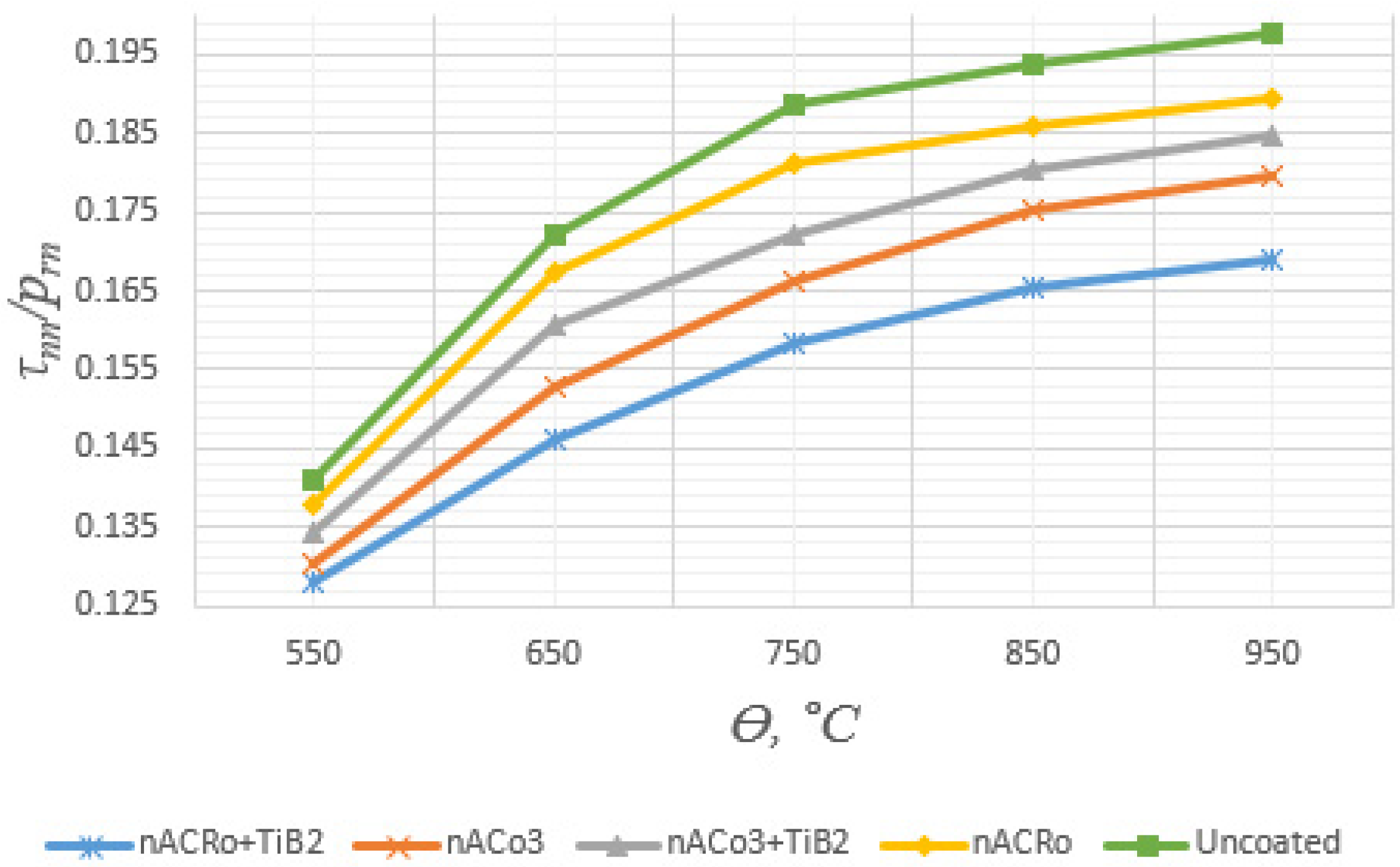
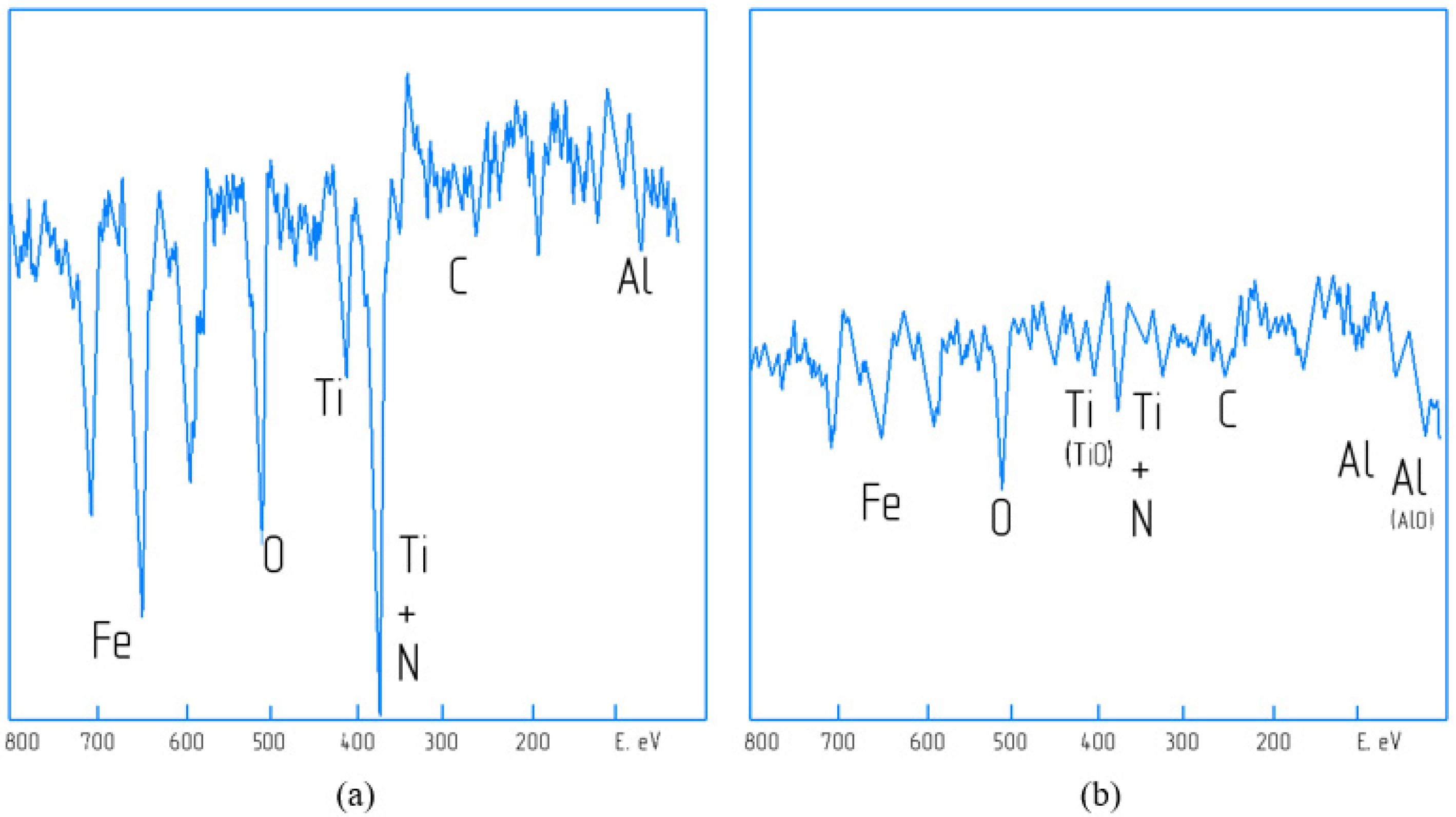

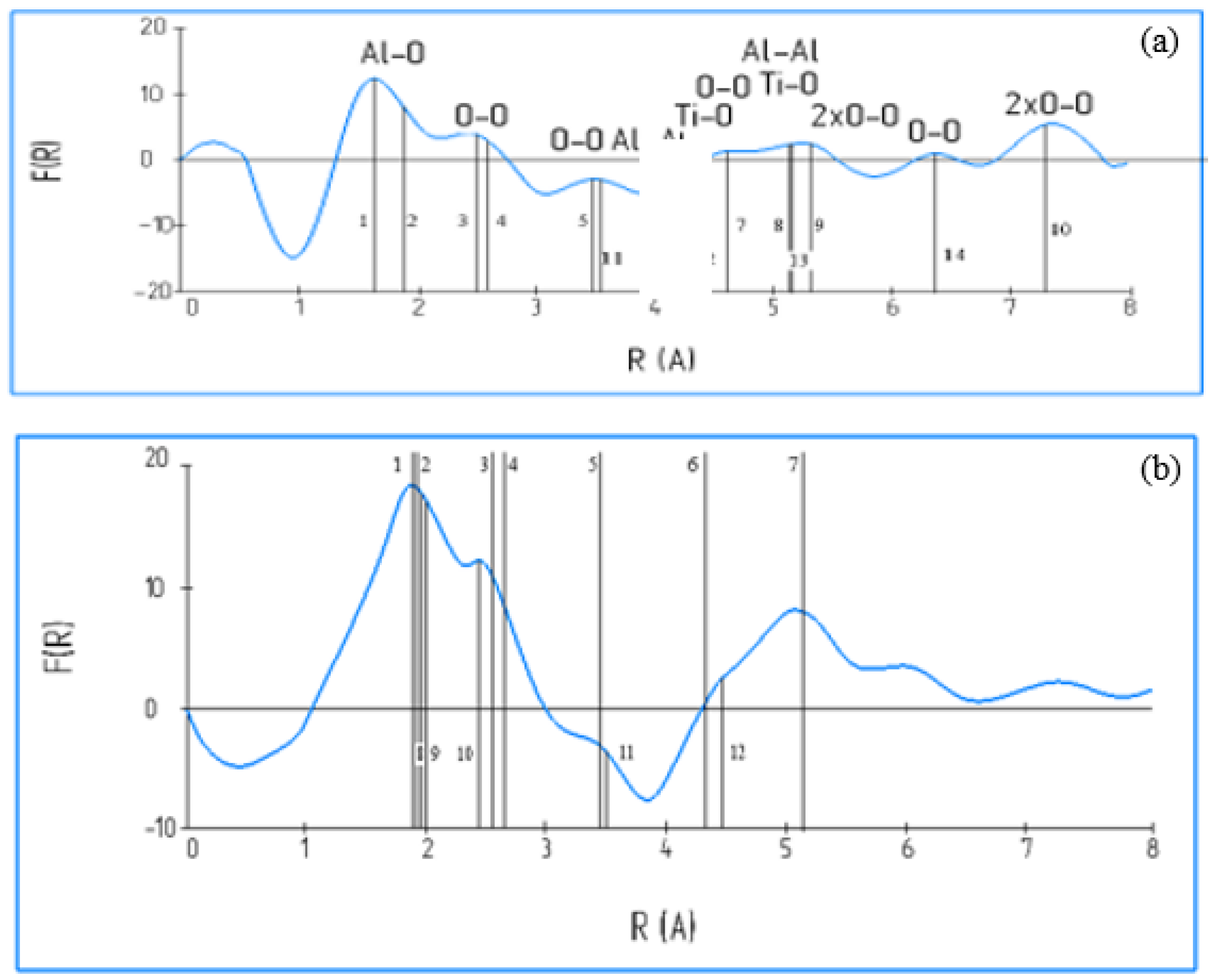

| Main Components, % by Weight | |||||
|---|---|---|---|---|---|
| Alloy | Ti | Al | V | Mo | Others |
| Ti64 | Basis | 5.5–6.75 | 3.5–4.5 | - | - |
| Ti811 | Basis | 7.5–8.5 | 0.75–1.25 | 0.75–1.25 | - |
| Parameters | Alloys | |
|---|---|---|
| Ti64 | Ti811 | |
| σ, MPa | 910 | 1141–1175 |
| δ, % | 7 | 7.2–9 |
| ψ, % | 15 | 14–16 |
| KCU, J/m2 | 2.5 | 0.19–0.24 |
| KCT, J/m2 | 7.85 | 2.5–4.1 |
| σ100/σT | ||
| 300 °C | 793 | - |
| 400 °C | 725 | - |
| 500 °C | 509/705 | - |
| 600 °C | 372/676 | 690/725 |
| σ−1, MPa | 284 | - |
| t (N = 2 × 107) °C | 550 | - |
| σ−1H, MPa | 147 | - |
| t (N = 2 × 107, Kt = 3.35) °C | 550 | - |
| σ0, MPa | 539 | - |
| t (N = 2 × 104) °C | 550 | - |
| σ−1H, MPa | 284 | - |
| t (N = 2 × 104, Kt = 3.35) | 550 | - |
| K1C, MPa·m1/2 | 59–68.7 | - |
Disclaimer/Publisher’s Note: The statements, opinions and data contained in all publications are solely those of the individual author(s) and contributor(s) and not of MDPI and/or the editor(s). MDPI and/or the editor(s) disclaim responsibility for any injury to people or property resulting from any ideas, methods, instructions or products referred to in the content. |
© 2023 by the authors. Licensee MDPI, Basel, Switzerland. This article is an open access article distributed under the terms and conditions of the Creative Commons Attribution (CC BY) license (https://creativecommons.org/licenses/by/4.0/).
Share and Cite
Migranov, M.S.; Shehtman, S.R.; Sukhova, N.A.; Mitrofanov, A.P.; Gusev, A.S.; Migranov, A.M.; Repin, D.S. Study of Tribotechnical Properties of Multilayer Nanostructured Coatings and Contact Processes during Milling of Titanium Alloys. Coatings 2023, 13, 171. https://doi.org/10.3390/coatings13010171
Migranov MS, Shehtman SR, Sukhova NA, Mitrofanov AP, Gusev AS, Migranov AM, Repin DS. Study of Tribotechnical Properties of Multilayer Nanostructured Coatings and Contact Processes during Milling of Titanium Alloys. Coatings. 2023; 13(1):171. https://doi.org/10.3390/coatings13010171
Chicago/Turabian StyleMigranov, Mars Sharifullovich, Semen Romanovich Shehtman, Nadezhda Aleksandrovna Sukhova, Artem Petrovich Mitrofanov, Andrey Sergeevich Gusev, Arthur Marsovich Migranov, and Denis Sergeyevich Repin. 2023. "Study of Tribotechnical Properties of Multilayer Nanostructured Coatings and Contact Processes during Milling of Titanium Alloys" Coatings 13, no. 1: 171. https://doi.org/10.3390/coatings13010171
APA StyleMigranov, M. S., Shehtman, S. R., Sukhova, N. A., Mitrofanov, A. P., Gusev, A. S., Migranov, A. M., & Repin, D. S. (2023). Study of Tribotechnical Properties of Multilayer Nanostructured Coatings and Contact Processes during Milling of Titanium Alloys. Coatings, 13(1), 171. https://doi.org/10.3390/coatings13010171








